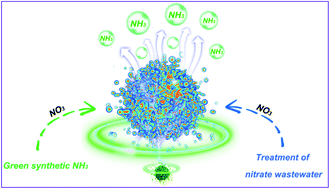Copper confined in vesicle-like BCN cavities promotes electrochemical reduction of nitrate to ammonia in water†
Abstract
Electrochemical methods to convert high-concentration nitrates present in sewage into high-value-added ammonia do not just alleviate the problem of environmental pollution but also provide less energy-intensive alternatives to the Haber–Bosch process. In this work, a metal–boron organic polymer precursor was annealed at high temperature to obtain copper nanoparticles encapsulated in a vesicle-like BCN matrix (BCN@Cu). In the electrochemical reduction of nitrate (E-NIRR), this species exhibited excellent catalytic activity. Specifically, the ammonia yields of BCN@Cu under applied potentials of −0.3 V, −0.4 V, −0.5 V, and −0.6 V versus the reversible hydrogen electrode were 271.1 μmol h−1 mgcat.−1, 354.8 μmol h−1 mgcat.−1, 435.6 μmol h−1 mgcat.−1, and 576.2 μmol h−1 mgcat.−1, respectively, and the corresponding Faraday efficiencies were 86.3%, 88.0%, 89.3%, and 88.9%. Isotope labeling experiments with 15NO3− confirmed that the detected ammonia had originated from the electrochemical reduction of NO3− on the catalyst surface. Moreover, the E-NIRR activity of BCN@Cu remained high even after using it ten consecutive times or 20 h of continuous operation, suggesting the practicality of the industrial application of BCN@Cu. The presence of copper was key in determining BCN@Cu's E-NIRR activity, while the presence of boron greatly improved its catalytic performance. Furthermore, density functional theory calculations indicated that BCN does not itself promote the reaction but rather assists the dispersion of Cu nanoparticles, thereby expanding the catalyst's active surface area.



 Please wait while we load your content...
Please wait while we load your content...